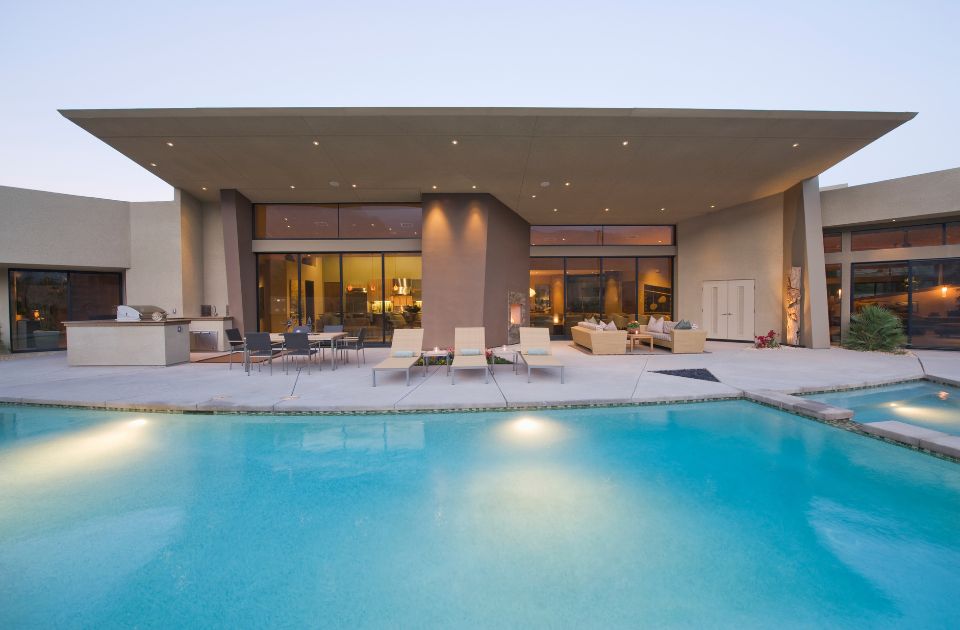Designing a Pool in Dallas
Determine what you want to do with your pool before you buy it: Make a plan for how you wish to use your swimming pool. Relaxation? Family fun? Entertaining coworkers? Is it going to be the center of attention? Expand your vision to include future choices like spas, outdoor kitchens, and shade structures once you’ve decided how you’ll utilize your pool. Make room in your design for the features you intend to add later, even if you don’t plan on using them right immediately.
Factors To Consider When Designing a Pool
Be aware of your neighbors who may oppose you building a pool. Make sure you’re aware of any local ordinances or regulations that could effect your plans before you begin. To avoid unpleasant surprises, make sure to integrate these considerations into your initial design.
Establish a Budget & Wishlist
Establish a budget and make rough sketches of potential layouts to help you narrow down your options. There’s a pool design that’s just right for you, no matter what your vision is or what your property constraints are. What are you looking for? Take a look at these incredible swimming pools.
Do you feel overwhelmed? It isn’t necessary. It is important to work with a reputable swimming pool company that has in-house designers that can help you create the final design and guide you through the installation process.
Planning Features & Amenities
Water features, lighting, and multi-dimensional landscaping are common additions to swimming pool designs. You can make your dream backyard a reality with the help of these unique elements. The pool’s design, on the other hand, will be critical to realizing this ambition.
Design With a Purpose
The first step is to figure out what you intend to do with your pool. Is your primary goal to have fun with your family? Exercise? Relaxation? Will you be hosting clients and coworkers for an evening of fun? Which would you prefer: a spacious patio for sitting or a playground with plenty of activities? How much sun and shade are you looking for? Does your home need ramps or other accessibility features?
Take into account the contour of the pool: straight, curved, angular or free form. Make an effort to consider the pool’s appearance from both the outside and inside of your house. Try to make your pool seem like an extension of your home.
Take your time with it. One of the most important things to consider when designing a pool is how you intend to use it. Once you’ve determined how you intend to utilize your pool, you can broaden your scope of consideration to include any potential future enhancements. Even if you don’t intend to use these features right immediately, it’s a good idea to leave place in your design for them.
Helpful Hints When Planning Your Pool Design
Your backyard can be transformed with the addition of spas, fountains, and other garden buildings. A play area, tanning deck, outdoor kitchen, and a garden, as well as fences and other unique landscape elements, should all be considered.
There are numerous ways to extend the use of your pool & patio by adding a heat source, such as a fireplace, firepit, patio flame, or pool heater. Inground pools benefit greatly from the installation of cabanas, pergolas, and trellises.
Your entire property’s aesthetic appeal and recreational value can be improved with the help of these solutions. To guarantee that your pool design will accommodate them, plan for them ahead of time. Take a look at pool designs to get an idea of the possibilities.
What to Be Aware of When Designing a Pool in Dallas
Now that you know what you want for your yard, it’s time to think about things that can make it less than ideal.
The City of Dallas requires a four-sided fence in order to meet the city’s setback requirements, as well as the closeness of your property to sensitive natural areas.
Become familiar with your yard’s natural lighting and drainage patterns. Drainage along property lines should retain a positive flow and current grades. As a result, the runoff will not pool and will instead be directed towards the catchment region.
For any project, there are a variety of obstacles and possibilities to deal with. Retaining walls may be restricted on a sloping yard, or a property with designated setbacks in a ravine. Alternatively, you may like to leave the trees, gardens, and hedges as they are. The presence of conservation areas, flood plains, or other green places means that some aspects of the project must be carefully considered before construction begins. A professional designer’s expertise comes in handy in this situation. When something appears to be a liability, it may actually be an asset in the long run. Shade structures can be created out of old shacks, for example.
Planning For Sucess
It’s time to move on from the formalities and think about the real-world implications. Getting from your residence to the pool area should be a breeze. How will guests enter and exit the pool area? Is there a place to get some food and drink nearby? Is there a place for the pool chemicals and equipment to be kept? Pool toys and accessories can be stored in a handy location. Consider practical challenges early in the design process to ensure they are taken into account.
Budgeting for Pool Construction
Set a budget for the pool project as early as possible. If you know exactly what you want and are aware of any limitations, you’re ready to make it happen. An expert pool builder can supply you with a set of accurate figures with which to work.
Developing a budget with your pool designer will be helpful in determining the scope of the project and in making design and material choices.
Sketching out a Design
Making a rough sketch of your yard’s layout not only helps you put your thoughts down on paper, but it may also serve as a visual reminder of what has to be changed and serve as motivation for future additions. Don’t stress about making a masterpiece here; this is the fun part.
Having completed this activity, you will be in a better position to work with a pool company’s in-house design team. In this way, you will be able to get the most out of the money you’ve allotted.
Consider Materials
It’s important to think carefully about the materials used to construct your pool. Concrete, vinyl, or fiberglass are the materials you can select from while building your home. See our Gunite Pools section for more in-depth information on luxury concrete pools and their features.
Decking, pathways, and other surrounding surfaces can be made from a wide variety of materials. Stamped concrete, paving stone, flagstone, ledgerock, brick, ceramic tile, mosaic tile, Ipe hardwood, cedar, and tempered glass are just a few examples of the many options available.
Use materials that go well with the design of your house if you can. You can also play with opposites to create a new design. It’s up to you to create the atmosphere you like, from a rustic cottage hideaway to a Japanese Zen garden to a luxurious resort.
In Conclusion
Most individuals are concerned about their privacy, both in terms of their visual and their aural perceptions, and your design should take this into consideration. A well-placed pool and garden structure, along with imaginative landscaping and elegant walls, gates, and trellises, may provide amazing seclusion for you and your neighbors.
The shape, size, and location of your pool can be affected by the terrain around it. As trees and bushes mature, they will change the amount of shade they provide, and the number of leaves they drop in your swimming pool, so be aware of this. In addition to providing seclusion, landscaping can also be used to soften hardscapes, enhance lushness, and elicit a certain mood. Consider using existing landscape elements in your design whenever possible.


